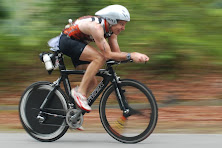 If you have been doing triathlons for any amount of time, I suspect you do a good job of sweating. Additionally, I'm sure you know that if you want to successfully complete longer training sessions and races you must avoid or delay dehydration caused by fluid losses from the body. Fluids are lost through sweating, breathing and using the toilet.
If you have been doing triathlons for any amount of time, I suspect you do a good job of sweating. Additionally, I'm sure you know that if you want to successfully complete longer training sessions and races you must avoid or delay dehydration caused by fluid losses from the body. Fluids are lost through sweating, breathing and using the toilet.Years ago the advice was "drink, drink, drink," with experts assuming there was no downside to consuming as much fluid as possible. Unfortunately, consuming large amounts of water without electrolytes can lead to a condition called hyponatremia. Hyponatremia, also known as low sodium concentration or water intoxication, occurs due to prolonged sweating coupled with the dilution of extracellular sodium caused by consuming large amounts of fluid with low or no sodium.
Electrolytes
Sodium, chloride and potassium are electrolytes, with sources divided on whether to include magnesium in that group as well. Electrolytes remain dissolved in the body's fluids as electrically charged particles called ions.
Electrolytes modulate fluid exchanges between the body's fluid compartments and promote the exchange of nutrients and waste products between cells and the external fluid environment.
There is actually an electrical gradient across cell membranes. The difference in the electrical balance between the cell's interior and exterior facilitates nerve-impulse transmission, stimulation and action of the muscles, and proper gland functioning.
If you consume too much water and not enough electrolytes, your body pulls electrolytes from its cells in order to create the right balance for absorption. If you consume too many electrolytes and not enough fluid, your body pulls fluids from within to create the right balance for absorption.
The bottom line is your body likes balance. Keeping your body in balance, or very close to balanced, is part of your challenge as a sweaty endurance athlete.
Average and Champion Sweat Rates
How much do we sweat? An average person sweats between 0.8 to 1.4 liters (roughly 27.4 to 47.3 oz.) per hour during exercise. To help you with a visual, the smaller bike water bottles typically hold 0.6 liters (20 oz.) of fluid and the larger bottles hold 0.7 liters (24 oz.) of fluid.
The highest recorded sweat rate for an athlete in an exercise situation is 3.7 liters (125 oz.) per hour, recorded by Alberto Salazar while preparing for the 1984 Summer Olympics. The highest human sweat rate recorded is 5 liters (169 oz.) per hour measured on a resting body exposed to a hot environment. At rest, the skin blood flow was maximum and not competing with exercising muscles.
How do you know if you are an average sweaty person or a champion sweater? You need to do some testing.
Your Sweat Rate Test
The easiest way to measure your sweat rate is to weigh yourself without clothes on before exercising for one hour. After an hour of exercise, return home, strip down and weigh yourself again. Assuming you did not use the toilet or consume any fluids during exercise, your weight loss is your sweat rate. For each kilogram of lost weight, you lost one liter of fluid. (For each pound lost, you lost 15.4 oz. of fluid.)
If you drink any fluids or use the rest room between the two weight samples, you'll need to include both of these estimated weights in your calculations. Add fluid consumed to the amount of weight lost. Subtract estimated bodily void weight from the total weight lost.
Be sure to record the heat and humidity conditions in your sweat test. Repeat the test in cool and hot conditions. Repeat the test for swimming, running and cycling because sweat rates will vary for each sport and vary with environmental conditions.
Now that you know your sweat rates in each sport, you probably imagine that simply drinking enough fluid will replace what you lose to sweat given the environmental situation. If it were only that easy.
Fluid Absorption Rates
Average fluid absorption rates range from 0.8 to 1.2 liters per hour (27.4 to 40.6 oz.). Unfortunately, while the sweat-rate range and the fluid-absorption ranges are close, some athletes sweat at higher rates per hour than their fluid-absorption rate. In short races, the rate discrepancy isn't much of a problem; however, for longer races the rate difference can lead to dehydration and decreased performance.
Nausea and vomiting can occur when athletes attempt to consume more fluids and fuel than their bodies can handle. Even if you manage to hold down the extra fluids, carrying beyond what your body needs is just unnecessary weight.
Champion Fluid Absorption Rates
I was unable to find any hard numbers for the maximum fluid-absorption rate documented in a laboratory. Most scientific literature suggests there is a range of absorption rates that varies from person to person. On the high end, I have worked with three people that can consume in excess of 41 oz. per hour.
On the low end, some people develop intestinal fullness, nausea and vomiting when ingesting fluid rates as low as 0.6 to 0.8 liters per hour.
Additionally, scientists have found there is a specific water carrier in the body (the water-channel protein, aquaporin) that influences fluid absorption. There is speculation that people without aquaporin--or very low levels of it--may have a reduced capacity to absorb fluid.
Case Study
During my coaching career I've had the opportunity to work with three champion sweaters and a couple of athletes I would consider low-volume sweaters.
The best data I have for a champion sweater is a male triathlete that weighs around 185 pounds. He recently completed a 90-minute run at a very aerobic pace of 10 minutes per mile at a temperature range of 84 to 92 degrees Fahrenheit with 70 percent humidity. He consumed fluid containing electrolytes, water and some electrolyte tablets during the run. His fluid consumption rate was 2.84 liters (96 oz.) per hour. He still lost weight.
This particular athlete has tested and retested himself to determine his sweat rate and to determine how much fluid he can comfortably absorb. When he runs on a hot day, even when he is acclimated to the heat, he routinely sweats at a rate of 3.6 liters (121.7 oz.) per hour. He routinely consumes 2.84 liters (96 oz.) per hour. Even consuming fluids at a relatively high rate, he loses 26 oz. of fluid or about 1.7 pounds per hour. Up to about 3.7 pounds (roughly 2 percent of his body weight), the weight loss has minimal affect on his performance.
Your Numbers
If you are looking to crack the code on your sweat rate and related hydration rate, you need to start collecting data during training and racing sessions. Know that your sweat rate is not a single number, but changes depending on several factors not limited to your fitness level, ambient temperature, humidity, clothing, exercise pace, stress level and rest level.
 Simon says: - Living in Malaysia has allowed me to acclimatize to a small extent but unfortunately my Anglo-Saxon roots and genes means that I sweat alot - and I mean alot - my sweat rate is between 2.8 and 3.2 ltres/hour in a race and depending on whether I'm swimming, cycling or running. Running is naturally the worst but cycling not far behind and although many people discount swimming as an issue I loose 2.5 litres and hour swimming (without a wetsuit).
Simon says: - Living in Malaysia has allowed me to acclimatize to a small extent but unfortunately my Anglo-Saxon roots and genes means that I sweat alot - and I mean alot - my sweat rate is between 2.8 and 3.2 ltres/hour in a race and depending on whether I'm swimming, cycling or running. Running is naturally the worst but cycling not far behind and although many people discount swimming as an issue I loose 2.5 litres and hour swimming (without a wetsuit).This is a big and very important issue for me especially in any races over three hours as my absorption rate is way behind my sweat rate. In IMMY 2010 I did the best job to date partially due to reduced weight loss leading to less stress on the system and less insulation. However, add a bit of wind to the heat and humidity (i.e. Ironman China just two weeks later) and the added dehydration effects left me in a dehydrated (walking) mess!
 I've no real words of wisdom to share other than don't ever underestimate dehydration on your performance and also don't make the mistake of many and ignore the swim section - if you jump on the bike blissfully unaware that you're already on the road to dehydration then you're going to have a very unpleasant time sooner rather than later.
I've no real words of wisdom to share other than don't ever underestimate dehydration on your performance and also don't make the mistake of many and ignore the swim section - if you jump on the bike blissfully unaware that you're already on the road to dehydration then you're going to have a very unpleasant time sooner rather than later.


1 comment:
Awesome info! I beleive that I am in the chmapion sweateer category, I will start collecting data so I dont end up in the ditch sleeeping and bloated on my first IM! Cheers
Post a Comment